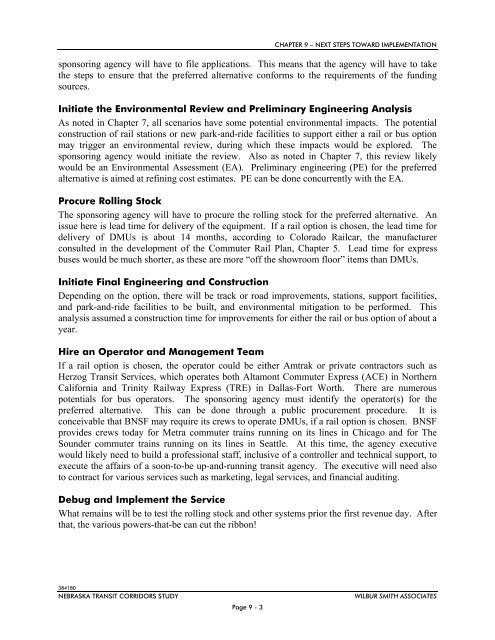NTRAC Final Study - Nebraska Department of Roads - State of ...
NTRAC Final Study - Nebraska Department of Roads - State of ...
NTRAC Final Study - Nebraska Department of Roads - State of ...
Create successful ePaper yourself
Turn your PDF publications into a flip-book with our unique Google optimized e-Paper software.
CHAPTER 9 – NEXT STEPS TOWARD IMPLEMENTATION<br />
sponsoring agency will have to file applications. This means that the agency will have to take<br />
the steps to ensure that the preferred alternative conforms to the requirements <strong>of</strong> the funding<br />
sources.<br />
Initiate the Environmental Review and Preliminary Engineering Analysis<br />
As noted in Chapter 7, all scenarios have some potential environmental impacts. The potential<br />
construction <strong>of</strong> rail stations or new park-and-ride facilities to support either a rail or bus option<br />
may trigger an environmental review, during which these impacts would be explored. The<br />
sponsoring agency would initiate the review. Also as noted in Chapter 7, this review likely<br />
would be an Environmental Assessment (EA). Preliminary engineering (PE) for the preferred<br />
alternative is aimed at refining cost estimates. PE can be done concurrently with the EA.<br />
Procure Rolling Stock<br />
The sponsoring agency will have to procure the rolling stock for the preferred alternative. An<br />
issue here is lead time for delivery <strong>of</strong> the equipment. If a rail option is chosen, the lead time for<br />
delivery <strong>of</strong> DMUs is about 14 months, according to Colorado Railcar, the manufacturer<br />
consulted in the development <strong>of</strong> the Commuter Rail Plan, Chapter 5. Lead time for express<br />
buses would be much shorter, as these are more “<strong>of</strong>f the showroom floor” items than DMUs.<br />
Initiate <strong>Final</strong> Engineering and Construction<br />
Depending on the option, there will be track or road improvements, stations, support facilities,<br />
and park-and-ride facilities to be built, and environmental mitigation to be performed. This<br />
analysis assumed a construction time for improvements for either the rail or bus option <strong>of</strong> about a<br />
year.<br />
Hire an Operator and Management Team<br />
If a rail option is chosen, the operator could be either Amtrak or private contractors such as<br />
Herzog Transit Services, which operates both Altamont Commuter Express (ACE) in Northern<br />
California and Trinity Railway Express (TRE) in Dallas-Fort Worth. There are numerous<br />
potentials for bus operators. The sponsoring agency must identify the operator(s) for the<br />
preferred alternative. This can be done through a public procurement procedure. It is<br />
conceivable that BNSF may require its crews to operate DMUs, if a rail option is chosen. BNSF<br />
provides crews today for Metra commuter trains running on its lines in Chicago and for The<br />
Sounder commuter trains running on its lines in Seattle. At this time, the agency executive<br />
would likely need to build a pr<strong>of</strong>essional staff, inclusive <strong>of</strong> a controller and technical support, to<br />
execute the affairs <strong>of</strong> a soon-to-be up-and-running transit agency. The executive will need also<br />
to contract for various services such as marketing, legal services, and financial auditing.<br />
Debug and Implement the Service<br />
What remains will be to test the rolling stock and other systems prior the first revenue day. After<br />
that, the various powers-that-be can cut the ribbon!<br />
384180<br />
NEBRASKA TRANSIT CORRIDORS STUDY<br />
Page 9 - 3<br />
WILBUR SMITH ASSOCIATES

















